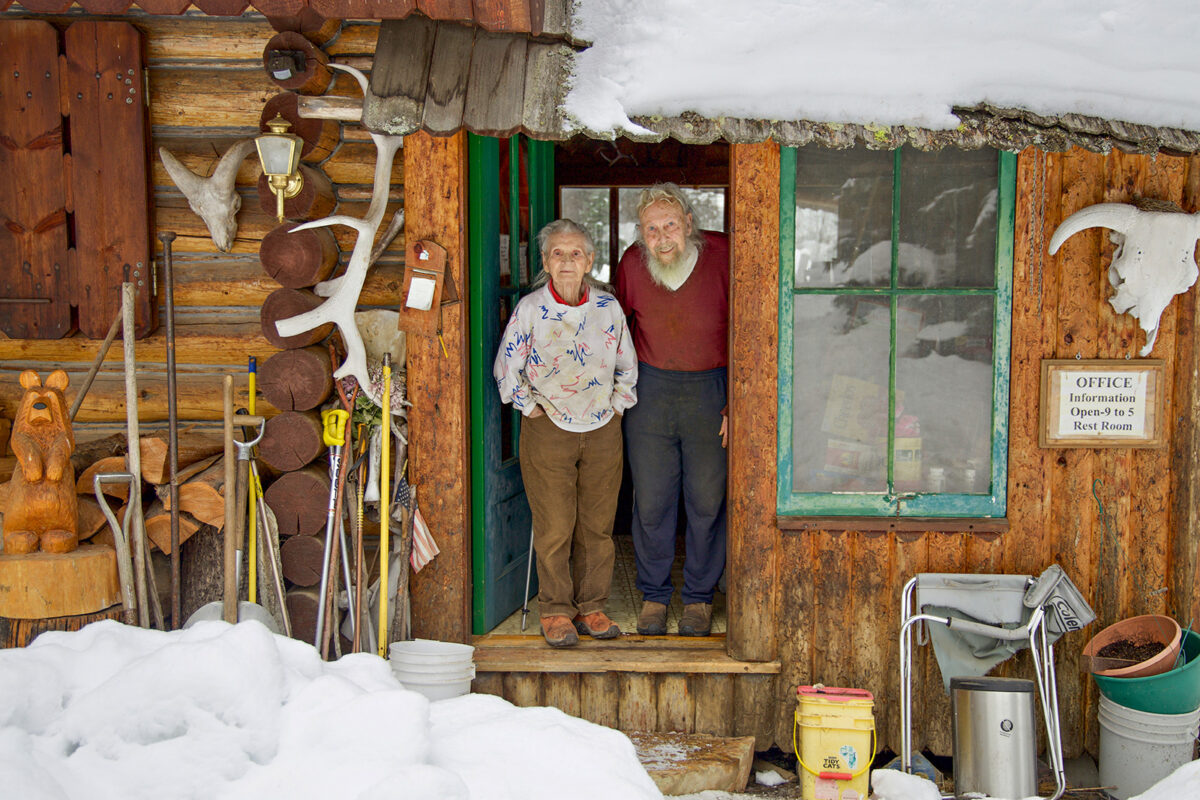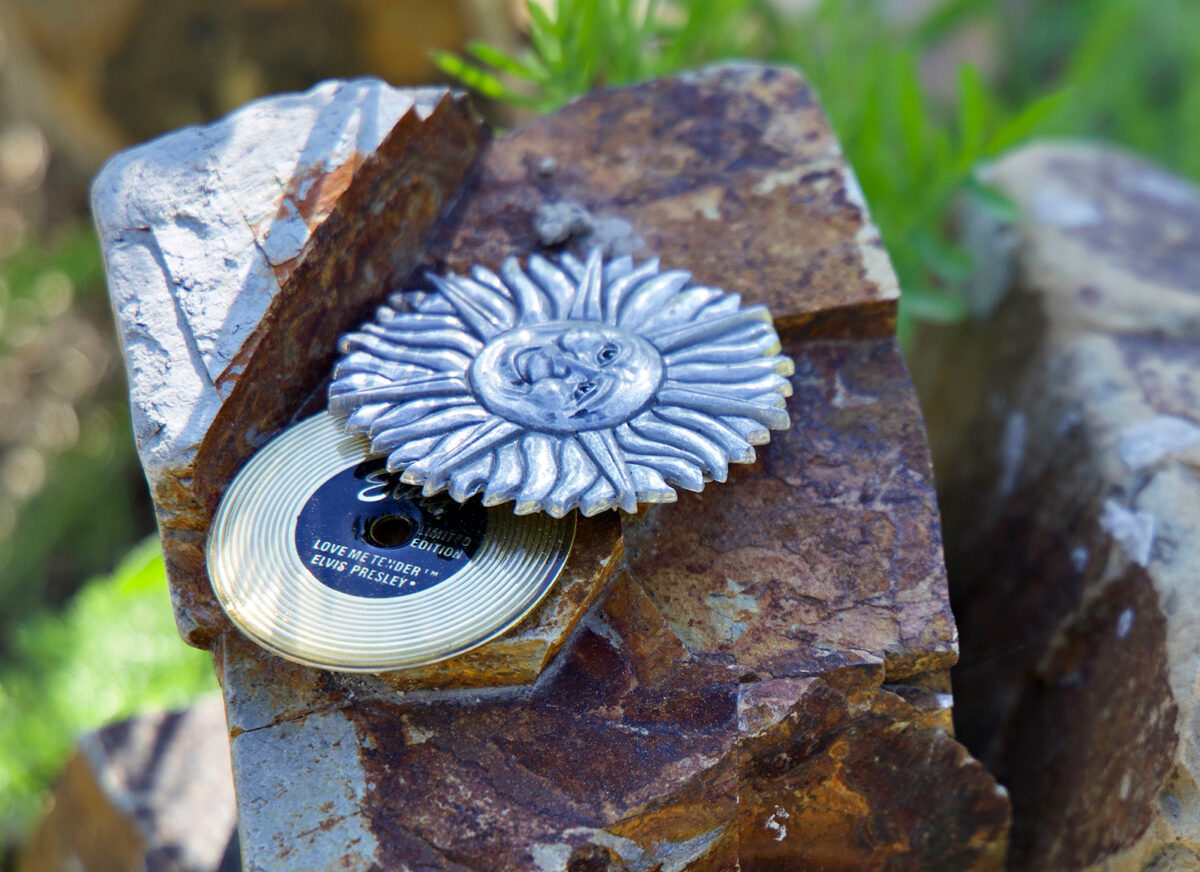
Deep in the Swan Valley forest, amid the stunning beauty of the Swan Mountains and along murmuring Lion Creek, is the home of Henry and Joan Meyer. Henry built the log house himself, cutting and hauling logs by hand to the site and using a block and tackle to hoist them into place. He says he worked on it when he could, so it became an ongoing project. Seventy-two years later they still dwell in the log home where they began a life together, raised four kids and built a business.
Just above their home on a ridge with towering larch, pine and fir trees, as well as a variety of wildlife, sits their future home – Natural Cemeteries, which they officially established in 2006.
“I didn’t want to go to town to be buried, I wanted to be buried at home,” Henry says.
He notes that Montana laws allow a person to be buried on your own ground, but the cemetery offered longtime protection to the site. He also liked the idea of providing a more natural burial option for his family, friends and neighbors. So, in 2005, he turned over his 120 acres to a nonprofit corporation that is recognized by the federal government and established Natural Cemeteries.
Henry has already built pine coffins for him and his wife, both 91, although he’s repurposed one of the custom caskets as a bookcase in their living room. They are no longer able to roam the vast Forest Service land and Bob Marshall Wilderness that lies next to their backyard, but they remain grateful that they can still gaze out at the Swan Range that looms so fetchingly, changing with the day’s light and the year’s seasons.
The story of Meyer Ranch and the cemetery really began over 70 years ago with two kids in Hoboken, New Jersey. Henry was attending high school and had his sights on marrying Joan Rodemer, a cute and spunky classmate. She was the proverbial cheerleader and he the football player. The restless teenager also had his sights on heading west. He had worked since he was 10 and managed to save a significant sum, especially for a boy not even legal to marry. The pair became engaged at 17 and eloped at 18.

Armed with his savings and a powerful sense of adventure he headed west with his new bride. He says his first choice was Alaska because it was wild and woolly; however, that plan was discarded when the draft board wouldn’t allow him to leave the country, as Alaska wasn’t yet a state. Instead, the newlyweds pointed their Chevy west to find their new home. Their search included several states, including California, Oregon, and Idaho, before they wandered into Montana. Henry says when a place caught his eye it was most often federal land. They went to the Forest Service office in Missoula to inquire about available land and were told, “Go up the Swan Valley. There is land for sale there.”
It was 1951, a decade before a state highway was constructed up the Swan, and the Meyers traveled up a primitive road that reached deep into the forest spanning the Swan and Mission mountains. They bumped along the rough road until they became stuck in the mud – stranded more than 2,000 miles from home, family and friends. Then along came a pickup truck driven by a local named Ray Fenby, who jumped out and proceeded to cut some poles to lift the Meyers’ rig out of the mud hole. Hearing their New Jersey accents, Fenby asked what brought them to a remote corner of Montana, and Henry explained that they were looking for land.
“I got some. I’ll sell you the land, but I get the timber,” Fenby replied.
It turns out that Fenby had made a practice of buying land for back taxes, logging it and reselling it. He even had a sawmill and offered Henry a job, where he worked while he began building a log home — until the Meyers’ new life was interrupted by the war.
Henry was drafted and after an aptitude test he was sent to light aircraft mechanic school. Henry says he felt lucky because he remained in the states working at an artillery center in Oklahoma where he was able to live with Joan. The mechanical training also came in handy when he returned home to resume building their home. He built a winch truck and worked on a variety of rigs and equipment.
Henry worked at a variety of trades, including doing custom log work with Swan Valley homebuilder John Stark. Afterward, he started Lion Creek Woodcrafts, a venture his sons would later join, constructing many of the area’s log homes and log furniture. He also worked for a children’s wilderness school until it faltered and closed.

Life was full of improvisation on what was still a remote and wild landscape. He tried raising cows, continued to work on their house, built fence and other structures and maintained equipment, in addition to running Lion Creek Woodcrafts. Joan stayed busy at home, too, devoting 16 years to work with the U.S. Forest Service. The couple’s oldest, Henry III, remembers the early days as “work, work, work.”
But then something happened. A new teacher arrived at their Salmon Prairie one-room schoolroom. Bill Jasper came with ambitious and non-conventional ideas – like installing a rope-tow on the nearby hill and teaching the children to ski. Kids were rewarded for good schoolwork and behavior with a trip to Big Mountain (now Whitefish Mountain Resort). Henry remembers, “The kids loved school so much they even wanted to go when they were sick.” Henry ended up chaperoning a ski trip and something happened. He had fun. According to Henry III, the family skied every weekend after that, eating pizza on the way home, and they began a tradition of backpacking and going to the lake in the summers. He says, “It changed our family’s lives.”
This new, more lighthearted phase of their life was embodied in the playful cartwheels and headstands his mom broke into along the trail – skills and abilities not surprising when you learn that she performed with her family in the circus while growing up in New Jersey.
Meanwhile, Henry, the patriarch, recaptured his youth and his sense of adventure. He became friends and skied with Whitefish’s legendary Danny On, a renowned nature photographer, forest ecologist, skier and conservationist. He accompanied another friend into the Bob Marshall Wilderness to check the snow survey courses. He says other adventures included being dropped off in Augusta and skiing over the mountains to reach home. He and Joan took a 200-mile trek through the Bob Marshall Wilderness leading horses that carried their supplies.
Their kids grew up and they grew older, as time always has its way. Henry retired before he was 50 when the log housing market fell off and they began to spend winters in Mexico, camping on the beach in their Volkswagen van. They remained active, with son Henry III remembering his mother teaching him to windsurf when she was nearly 60. Even as the years passed and Henry’s body began to tell the story of a lifetime of hard work and play, they managed to remain at their beloved home, aided by visits and assistance from family members.
Henry and Joan were nearing their 80s when they began to think about the inevitable end. They wanted to keep it simple and as natural as possible — and they wanted to be buried at home.

“I love the land. I love this place,” Henry says.
The couple’s younger son, Peter, helped them wade through the legal process of setting up a natural cemetery. Their goal was “to provide a community cemetery in a forest environment where earth’s natural process is used to recycle human remains in a way that harmonizes with nature.”
The cemetery also offered nature trails and a place for meditation and education, where visitors can observe nature and how it works. Important to Henry was that the natural setting of the cemetery also preserve fish and wildlife habitat and corridors where the elk, deer, mountain lion, grizzly bear and moose roam. He smiles and quips, “The animals can get along with the people in the cemetery real well.”
In January 2006, the process was complete, and it became the first natural cemetery in Montana. Because Henry III is the only one who lives in the area, he helps with the cemetery upkeep, burials and paperwork. Henry III laughs when he says, “I never thought I would inherit a cemetery.” The younger Henry’s son, Marshall, has done the engraving on a few of the small headstones, making him the third generation to become involved in the cemetery.
There have been approximately 20 burials to date. Funeral services have included singing and accordions or simply the sounds of the wind and the birds that pass through here. Markers have included a Buddha statue, a small metal moose sculpture, low-lying rock headstones, and a simple engraved wood board.
The couple has picked out their spot along the ridge where they can see their home, the steady Swan Range that sits over the property like a gigantic headstone, and what Henry says is one of the largest larch trees in the country.
On a summer day, the bear grass bows and sways in a gentle breeze while the sounds of songbirds bounce among the ponderosa punctuated by the chatter of a squirrel. The sun flashes across the navy-blue Swan Mountains that are still capped with snow. Peaceful. Beautiful. You might even say, heavenly. And for Henry and Joan Meyers, it is their forever home.

The Natural Cemeteries is located down Natural Cemeteries Road in the foothills of the Swan Range. The cemetery is based on a simple philosophy: “Live and die in harmony with nature.”
A simple wood or biodegradable casket or blanket shroud is encouraged for burial. Grave markers such as low-lying natural rock headstones or planting a native tree or flower is also recommended. To prevent poisoning the land, embalming is discouraged, which makes refrigeration or burial in the first 48 hours after death necessary.
The current price for a cemetery site is approximately $2,000, with the cost of a burial site $900 and an “open and close” burial fee of $1,000. The “open and close” fee for ashes burial is $200. A minimum donation of $100 will qualify the donor to membership with the right to reserve a burial site. The Perpetual Trust Fund Montana law requires 15% of the cemetery member fee be paid to ensure future funds to manage and maintain the cemetery as a whole.
The contracts includes other details regarding the cemetery and a disclaimer that notifies visitors that they enter at their own risk to protect the cemetery corporation from liability while still providing visitors the freedom to wander on the property during cemetery hours. In closing, the contract reads: “The bear and elk thank you. The birds and little critters thank you and most of all Natural Cemeteries thanks you!”